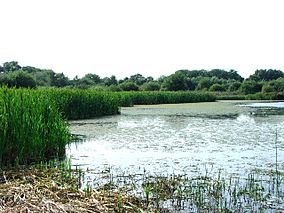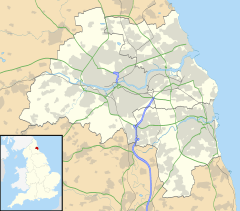Gosforth Nature Reserve facts for kids
Quick facts for kids Gosforth Nature Reserve |
|
|---|---|
|
IUCN Category IV (Habitat/Species Management Area)
|
|

The lake on the reserve
|
|
| Nearest city | Newcastle upon Tyne |
| Area | 65 ha (160 acres) |
| Operator | Natural History Society of Northumbria |
| Website | https://www.nhsn.org.uk/gosforth-nature-reserve/ |
Gosforth Nature Reserve is a special place for wildlife in Tyne and Wear, England. It has lots of different natural areas, like thick woodlands and wetlands (areas of land covered by water). The Natural History Society of Northumbria looks after this reserve. You can usually visit if you are a member of the Society or have a day pass. To protect the animals and plants, activities like dog walking are not allowed here. The reserve is part of Gosforth Park, which used to be a big estate with a large house.
Contents
History of Gosforth Nature Reserve
How the Reserve Was Formed
Long ago, in medieval times, the land where Gosforth Nature Reserve now sits was used for farming. You can still see some old ridge and furrow marks, which are signs of how fields were plowed. The area was mostly heathland, which is why a nearby village is called West Moor and a track is named Heathery Lane.
Later, the Brandling family bought the land. They built a large estate house and changed the landscape around it, which was popular at the time. They planted new trees to create woodlands and dug a new lake. This lake was used for boating and fishing. Maps from the past show that the lake was made between 1810 and 1820. Most of the woodlands were planted around the mid-1800s.
Becoming a Wildlife Haven
Towards the end of the 1800s, the Brandling family faced financial difficulties and sold their estate. After this, nature slowly started to reclaim the land. In 1924, a man named Mr. W. E. Beck wanted to protect the wildlife from hunting. He leased the rights to the lake and nearby woodlands. Mr. Beck was a member of the Natural History Society of Northumbria. In 1929, as he became unwell, he passed his rights to the Society. Since then, the Society has managed this area to help wildlife thrive.
Amazing Habitats and Wildlife
Gosforth Nature Reserve is home to many different plants and animals because it has various habitats.
Wetland Wonders
A big part of the reserve is a very important wetland. This area has lots of tall Phragmites reeds and open water. Around the wetland, there's a type of wet woodland called carr woodland. These wet areas are perfect for many birds that nest there, like the reed warbler, water rail, reed bunting, sedge warbler, common tern, and little grebe.
In winter, you might see birds like the bittern, kingfisher, wigeon, teal, and shoveler. You can also find aquatic mammals here, such as the otter, water vole, and water shrew. The reserve also has England's second-largest group of coralroot orchids, which are rare and beautiful plants.
Woodland Life
Most of the reserve is natural woodland, mainly filled with oak and birch trees. There are also some areas with conifer trees, which are evergreens like pines. In these woodlands, you might spot mammals like the badger, fox, roe deer, and stoat. Red squirrels, which are quite special in the UK, also live here. Most importantly, the woodlands support a huge variety of insects, including many rare kinds.
Meadow Magic
There's also a small meadow area in the reserve. Here, you can find plants like heather and the northern marsh orchid. These open areas add to the different types of habitats available for wildlife.
A Special Protected Area
What is an SSSI?
Gosforth Park Nature Reserve was named a Site of Special Scientific Interest (SSSI) in 1977. This means it's a nationally important area for its wildlife, geology, or landforms. Being an SSSI helps protect the site and its unique features.
The reason it was given this special status is because it's very important for its insects. It has many different kinds of invertebrates (animals without backbones) that live in its water, grasslands, and woodlands. These include two species that are nationally rare: a small beetle called Triplax scutellaris and a solitary bee named Adrena alfkenella.
Who Owns and Manages the Reserve?
Ownership and Access Rules
The nature reserve is still part of Newcastle Racecourse, which is owned by a company called Arena Racing Company. It's located just north-east of the Whitebridge Park housing area. The land is leased to the Natural History Society of Northumbria, who manage it.
To keep the wildlife safe and undisturbed, there isn't general public access to the reserve. There are no public footpaths or rights of way through it. However, members of the Natural History Society of Northumbria can visit. If you're not a member, you can often buy a visitor pass when you arrive. The Society also holds regular public open days and runs activities for school groups and local people to learn about nature.
Images for kids



